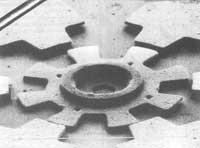Microscopic electric motors
We all know about how small is the thickness of a sheet of paper or hair, which measures a tenth or two of the millimeter. Therefore, it is not to believe that there is an electric motor less than the thickness of a hair. The electric motors we have known so far are of very different dimensions. Some are impressive (4,500 kW, for example, from the train machine) and others a few millimeters (for example, quartz watches).
All these electric motors are based on magnetic force. In short, they are based on the ability of a magnet (or electromagnet) to attract a piece of iron. To increase this magnetic force, the electromagnets have a coil through which the electric current is passed and a high intensity magnetic field is created. In miniaturization, however, threads, insulation and winding present insurmountable obstacles.

The smallest motors currently used based on magnetic force are quartz clocks. They operate in alternating current and although the rotor measures one or two millimeters, the stator usually exceeds the centimeter with its coil.
But despite the obstacles, at the University of California (Berkeley), Roger Howe and Richard Muller manufacture an electric motor as small as hair thickness. The motor has no winding and can only be seen with the microscope. In addition, in principle it is not an electromechanical motor but an electrostatic one, since it takes advantage of electrostatic force (and not electromagnetic).
Electrostatic force is a phenomenon that we can see every day. There is nothing more to see how expanded polystyrene foam attracts plastics or how the music disc attracts dust. The force of attraction between two electrical loads of opposite sign in electrostatic is directly proportional to the values of the loads and inversely proportional to the square of the distance between both. Therefore, if the distance between loads is half, the force of attraction will be four times greater and if the distance is ten times smaller, the force one hundred times greater, etc. Therefore, although electrostatic forces are very small in themselves, it should be noted that the distance between loads is less than the millimeter. In integrated circuits, on the other hand, the distance between the components is one thousandth of a millimeter, measures in which electrostatic forces can be used as a driving force.
Therefore, in this new microscopic electric motor, small parts must be manufactured with enormous precision, as well as the components of the integrated circuit. Thousands of transistors have long been being introduced into a square of 5 mm silicon length.
The process of elaborating integrated circuits is based on photolithography. The circuit drawn in a template is projected as a slide to the silicon square. Rather, they project the reverse of the slide, reducing the size and not increasing. By projecting the template image to the layer of sensitive lacquers located on the silicon plate, the subsequent treatment only allows to keep in the layer the illuminated areas (or vice versa). There are other similar procedures for the realization of integrated circuits.
On the contrary, these procedures, in addition to transistors, include detectors, pressure sensors, accelerometers, etc. began to be used for their design and engineers have achieved the electric motor. The engine is built in a polycrystalline silicon layer, which is taken as a sandwich by the other two layers of silica.
The outer shape of the motor is what these layers present. Silica makes of mold or shell. Once deposited inside the sufficient layer to form the moving parts, the outer mold dissolves in hydrofluoric acid, exposing the engine parts. The rotor is similar to asynchronous motors. It is adopted the form of a gear of eight or twelve teeth with a diameter of 6 or 7 centimeters of mm, less than the thickness of the hair. The stator is directly carved into the silicon support. It has a circular orifice to enter the rotor and metallized notches around to generate rotary electric field by alternating current. The distance between the rotor and the stator (known as mezzanine in normal motors, but here you should call it silicon) is 0.5 millimeters.
The microscopic motor works the same as the normal asynchronous motor. When in a certain direction the current is sent to the unevenness of the stator, its extreme electric field induces a contrary electrification in the rotor teeth and, being attracted by loads of opposite sign, the rotor turns approaching the notches.
However, before reaching the balance, the direction or distribution of the bleeding current changes and the rotor teeth are pushed with repulsion force. By controlling the stator current as a magnetic field in classic asynchronous motors, the rotor rotates continuously. The chip is to control this stator current. The microscopic motor is inside the microprocessor.
On the other hand, this modest motor will generate problems different from the previous ones, since they do not know the influence of friction and wear on those dimensions. How to grease parts for example?
However, there is another important question: What will these engines be used for? And it is not so difficult to answer. The microprocessor will be the governing brain and the muscle working the microscopic motor. For microsurgery, scissors or circular saws, such as the retina of the eye or cutting small cells in another organ, will be constructed. Or they will remove fat from the arteries or by microscopic valves they will expel exact doses of drugs at a certain time and place.
Of course, also in the industry. In the alignment of laser diodes, fiber optic telecommunications, etc. They are also of great interest to satellites and space probes, as their size and weight are of vital importance in this field.





